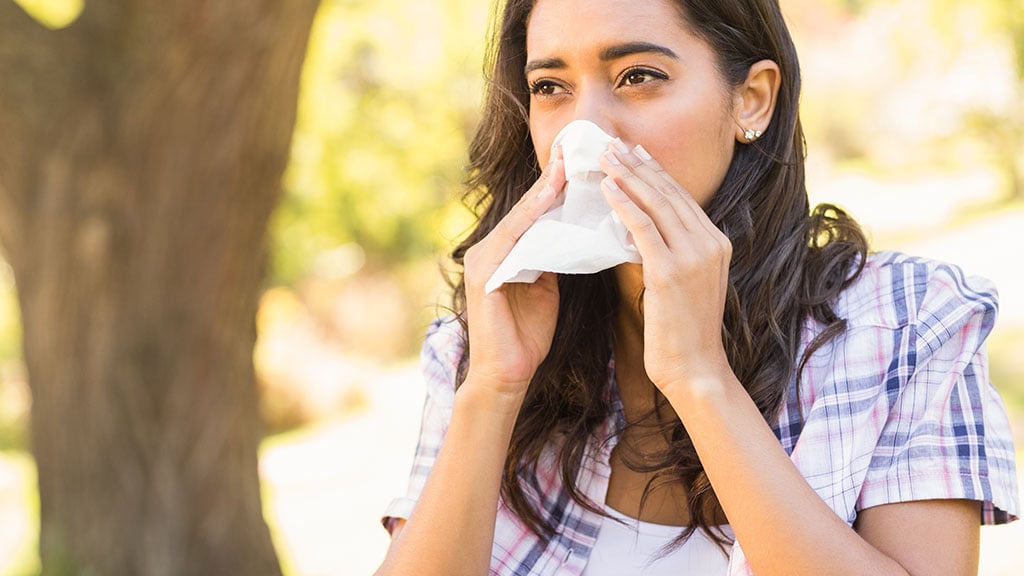It’s hay fever and thunderstorm asthma season: here’s what you need to know
Are you among the one in five Australians affected by hay fever – which causes sneezing; a runny or stuffy nose; itchy ears, nose and throat; red, itchy or watery eyes; headaches; and trouble sleeping or concentrating?
Hay fever – also called ‘seasonal allergic rhinitis’ – is an allergic reaction that makes the tiny hairs and mucus in the nose trap dust, pollen and other microscopic particles. A person with hay fever is allergic to some of these particles.
With another wet spring, the production of pollen – the most common cause of hay fever in Victoria – is in overdrive. This means that hay fever sufferers may be even more affected than usual.
According to Asthma Australia, roughly 80% of people with asthma also experience allergies. In addition to irritating your sinuses, increased pollen counts during spring can be a possible trigger for asthma flare-ups or attacks.
How to prevent hay fever
If you suffer from hay fever, you should keep a close eye on the pollen count forecast:
- Deakin AIRwatch is a pollen counting and forecasting service that provides the pollen count at our Burwood and Waurn Ponds campuses from 1 October to 31 December each year.
- Melbourne Pollen provides other pollen count and forecast sites in Melbourne and around Victoria.
On days with a high count, on windy days or after thunderstorms, try to stay indoors as much as possible or always keep your medication with you.
In your garden, choose plants that are pollinated by birds or insects, rather than plants that release their seeds into the air. Try to reduce your exposure to dust and dust mites, animals and animal hair or fur, and regularly splash your eyes with cold water to flush out any pollen.
How to treat hay fever
It’s best to seek the advice of a health professional, who may suggest any of the following:
- Intranasal corticosteroid sprays – containing a very low dose of steroids, they’re one of the most effective treatments for allergic rhinitis if used regularly.
- Non-sedating antihistamine medications – useful to control sneezing and itching, but not as effective if symptoms are severe. Seek advice if you’re breastfeeding.
- Eye drops – may relieve itchy, swollen or runny eyes. Ask your doctor or pharmacist for advice on choosing the correct eye drops.
- Decongestant nasal sprays – useful for quick relief but should not be used for more than five days, as long-term use can damage the lining of the nose. Certain people should not use decongestants (for example, if you’re pregnant or have high blood pressure), so discuss with your doctor or pharmacist.
- Allergen immunotherapy – exposes a person to increasing amounts of an allergen to improve tolerance and reduce symptoms. Seek advice from your doctor.
How pollen can cause thunderstorm asthma
Thunderstorm asthma can occur when hot, dry, windy and stormy weather causes pollen grains to break into tiny pieces. If you breathe in these pieces, they can get deep into your lungs and cause asthma-like symptoms, only more intense. They can include breathlessness, a tight feeling in the chest, wheezing and coughing – and can escalate quickly and dangerously.
The highest risk period is from October to December, and you’re not only vulnerable when there’s a storm – thunderstorm asthma can occur on hot and windy days too.
If you suffer from asthma or hay fever, download the VicEmergency app (Google Play or the App Store) and set up a ‘watch zone’ for your location to receive warnings of oncoming storms. Also check the Victorian three-day epidemic thunderstorm asthma forecast by region. If a storm is coming, stay inside, close all doors and windows, and turn your air conditioner off.
Thunderstorm asthma can also affect anyone – even if you’ve never experienced symptoms of asthma or hay fever before.
How to treat thunderstorm asthma
In an emergency, call Triple Zero (000) or be ready to administer asthma first aid.
The relationship between asthma, hay fever and thunderstorm asthma is complex. Treatment will vary depending on your combination of symptoms and if you’ve had symptoms before.
If you have asthma or hay fever, or you’ve been experiencing new symptoms, it’s best to see your doctor each year for a check-up and/or to update your asthma management plan – make an appointment with the Deakin Medical Centre now.
For more information, visit the National Asthma Council Australia, Better Health Channel or Asthma Australia.
